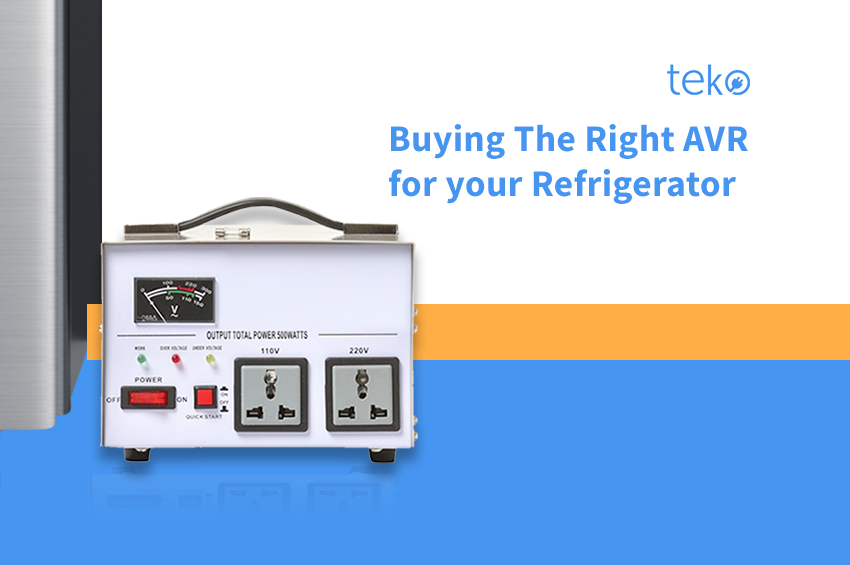
It’s no secret that power surges and sags are common in the Philippines. That’s beyond our control, but there are ways you can protect your appliances from damage due to voltage fluctuations. We’re Teko.ph, the largest aircon and appliance services provider in the Philippines, and we highly recommend using an Automatic Voltage Regulator. Here’s a quick guide on using an AVR for refrigerator.
Do you need an AVR for refrigerator?
The safe answer is yes. However, it’s probably safe to go without one for certain smaller, low-cost refrigerator models. The larger, more costly machines require this security since their electronics are more sensitive, and, well, because they’re more expensive, it makes sense to protect them. These types include inverter models and those with functions such as door-in-door and water dispensers.
However, suppose you reside in a region where the power supply is notoriously unstable. In that case, you should reconsider acquiring an AVR for refrigerator even if you have a relatively simple ref model. This would significantly extend the life of your equipment.
When in doubt and an AVR is well within your financial limits, get one regardless of the type of your refrigerator. Just remember this simple rule: the more expensive the appliance, the greater the likelihood it needs an AVR.
Ask Tech Alex if you need more expert assistance using your home refrigerator. You can get answers 24/7 through our virtual technician.
Servo-motor type vs. Relay-type AVR: Which one should I get?
There are two main kinds of AVRs on the market: servo and relay. The mechanical elements of a servo-motor AVR are used to adjust the input voltage. This results in a reliably accurate voltage regulation that maintains a constant voltage of 220V. These models can, however, break the piggy bank.
Meanwhile, a relay-type AVR is less complicated; it employs an electrical circuit to keep the voltage constant at 220V. This is less accurate, but it gets the job done and is far less expensive.
Most people will be OK with a relay type, but if money is no problem and you want additional peace of mind, go with the servo kind.
What AVR capacity should I get?
For appliances that utilize a motor (such as a refrigerator’s compressor), the AVR rating should be at least three times the rated wattage of the fridge. This is to account for the surge in power that occurs when the compressor is turned on.
For instance, if your ref has a rated input of 130W, a defrosting input of 150W, and a 10W bulb, get the total and multiply by three.
AVR capacity needed (130W + 150W + 10W) * 3 = 870W
In our example, you should obtain an AVR with at least 870W; therefore, a 1000W is your best bet. If you can’t decide yet, you may call a representative from an AVR manufacturer in the Philippines, who can advise you in selecting the best AVR for your needs.
AVR for Refrigerator: Features to Look For
1. Surge protection
AVRs can withstand power surges, but for exceptionally severe ones, those with a built-in surge protector can turn off the refrigerator just in case.
2. Circuit breakers and fuses
The AVR itself must avoid power surges itself. When it detects a surge, a fuse blows. This prevents power from reaching the AVR and refrigerator. You should get AVRs with readily changeable fuses, which will allow you to replace a fuse if one of them pops due to a surge.
3. Turn on the delay function.
The built-in power-on delay automatically turns on the fridge 3-5 minutes after a power interruption to ensure that the power stabilizes before the refrigerator is utilized.
4. Built-in transformer
If you have a refrigerator that’s from overseas, you will need a transformer to be use it because most of those have a 110 voltage rating. Some AVRs include a built-in transformer that transforms the usual 220V power supply in our sockets to the 110V required by those imported refrigerators.
Conclusion
Refrigerators are pricey upfront, but if properly maintained, they will survive for decades. Due to the unstable nature of our electricity in the country, it’s a wise choice to get an AVR. In doing so, make sure you get one with adequate capacity and the valuable features to make your purchase worthwhile.
